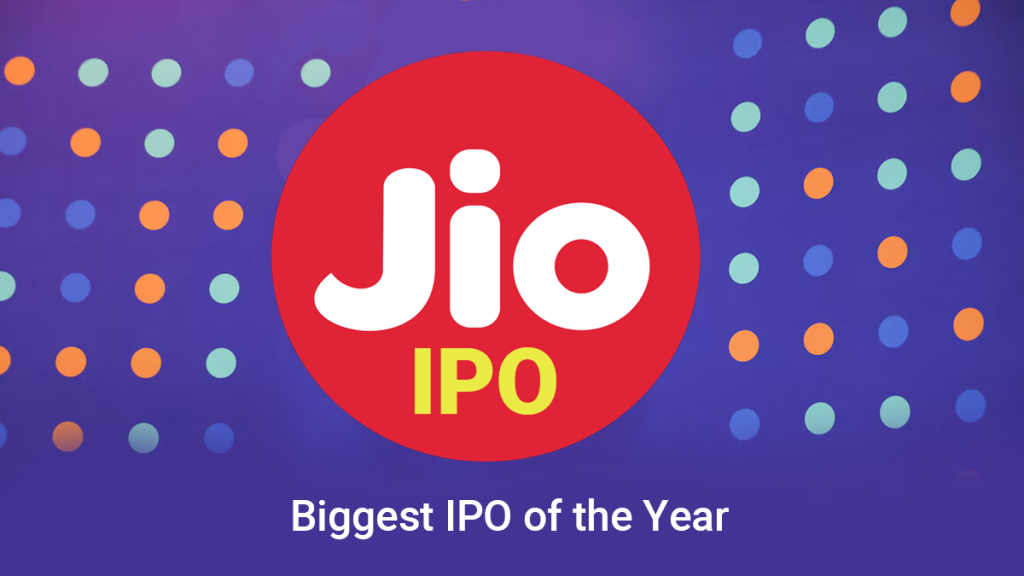The biggest Initial Public Offering (IPO) process of the year will leave records behind, Courtesy of Reliance Jio Infocom, a company by Reliance Industries. The IPO, estimated to generate up to $120 billion, is expected to cause ripples around global financial markets. We’ve decided to break it down and explain precisely why this IPO is the biggest IPO of the year and is a landmark event.
At $120 billion valuation, Reliance Jio is one of the largest IPOs ever in India and a top IPO globally. The valuation also accounts for the company’s massive success in changing India’s telecom sector which was done in the affordable and the most seamless 4G connectivity way. By comparison, the value of Jio is higher than that of its peers, including Bharti Airtel ($50 billion market cap) and Vodafone Idea ($3 billion market cap).
Jio was launched in 2016, and since it has changed the dynamics of the telecom industry and in two years it has over half a billion subscribers. Nearly 40% of its market share in the Indian telecom sector shows its dominance. Expansive infrastructure and new standards of pricing the company has set for affordable connectivity in India.
Reliance Jio Revenues in the fiscal year 2023-2024 stood at $18 billion, as compared to $16 billion in the previous year. For all its stage peril, a positive note was struck by the company when it announced a net profit of $2.5 billion. Fantastic cost management resulted in impressive EBITDA (Earnings Before Interest, Taxes, Depreciation, and Amortization) margins of 50%.
India’s Jio is not your average telecom company because it is a digital ecosystem including broadband, e-commerce, cloud computing, and content streaming. In fact, its platforms such as JioCinema, JioMart and JioFiber, play a major role in its revenue streams and help it become a diversified player in the digital economy. With marquee content and partnerships with global names such as Meta, Google and Microsoft, Jio can push its growth really fast.
Global investors, from sovereign wealth funds, private equity players and tech giants, have already taken notice of the IPO. Jio’s international appeal is underlined by big investments from companies such as Facebook (now Meta), Google that together poured in over $10 billion. Analysts also expect strong institutional and retail participation as Jio is known to be an innovator and profitable service provider.
It will also unlock value for Reliance Industries (RIL) which owns 66.5 percent of Jio. IPO proceeds will likely be used reduce Reliance’s net debt of about $30 billion, and pay for future growth. This is a step closer to Chairman Mukesh Ambani’s dream of making Reliance a global tech powerhouse.
At a time when India is becoming more and more visible on the global economic stage and where people are increasingly eager to back technology-related businesses, IPOs coming into the market are timed right. Indulge in the presence of lucrative market conditions as we can’t leave behind the fact that India has surpassed the growth of 6%, sealing a prosperous listing.
The offering could fuel India’s biggest initial public offering, relying Jio plans to garner between $8 billion and $10 billion. Jio’s plans would dwarf Paytm’s $2.5 billion of India’s largest IPO in 2021.
While Jio has been on a stellar growth trajectory, it continued to face hurdles such as price of spectrum, regulatory constraints and deep competition. Loosely speaking the Indian telecom market has always been challenged in the long term profitability end due to lowest ARPU (Average Revenue Per User) of Indian telecom of $2.5 – 3, lowest among the lowest globally. Global economic uncertainties such as inflationary pressures, geopolitical tensions, etc. could have an impact on investor sentiment.
India’s rise in tech and telecom sectors is evident from the fact that the IPO has happened. A successful listing will raise the Indian stock market’s global footprints and also bring in more foreign investments. That means Jio’s IPO could act as a benchmark for other Indian unicorns thinking about going public.
In the final stage of appointment of underwriters and filing the draft red herring prospectus (DRHP), Reliance Jio is. It plans to hit the markets with an IPO mid-2025, if approved by regulators. The record of the company and its future potential the company has should see the shares oversubscribed.
While its affordable price band of Rs 1,500 to Rs 2,600 for retail investors is anticipated to draw millions of small investors across India. Since Jio has such a strong brand name, and it’s such a low cost IPO, many first time investors could make it to the IPO in record numbers. Studies suggest that one should subscribe for long term wealth creation by it as Jio is a diversified business model and does consistent growth.
The Reliance Jio IPO isn’t just a financial event it’s the marker of a major turn in the growth of the digital economy in India. Jio certainly has aspirations for an ambitious valuation and creative approach to the marketplace. That would be a truly game changing moment in global financial markets and investors here and abroad are eager to see how it plays out.
To that effect, Reliance Jio’s IPO is an important one, not just for the company but for the Indian economy as a whole. India’s potential as a global tech, and telecom hub and investors’ opportunity to partake in a transformative digital journey are highlighted. As the IPO begins it promises to set new benchmarks in the financial markets and change the narrative of India’s digital growth story.
For investors seeking guidance in navigating such transformative opportunities, platforms like Jarvis AI offer cutting-edge tools for identifying multibagger stocks and providing AI-based stock recommendations. Recognized as one of the best share market advisors in India, Jarvis AI specializes in top stock picks for long-term investment and portfolio advisory services, enabling investors to make informed decisions and achieve their financial goals.
